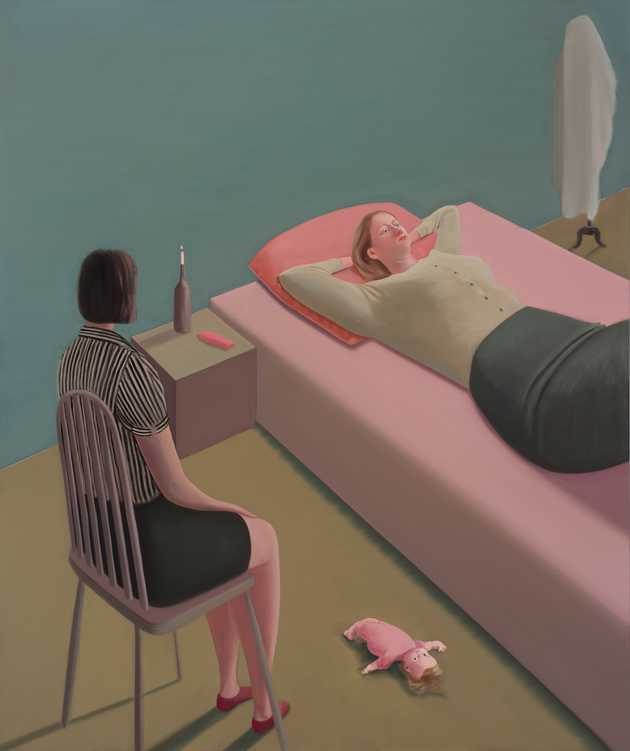See Me
Personal Essay by Emma Cline
When I was thirteen, I had a yearlong correspondence by mail and over the phone with Rodney Bingenheimer. A peculiar icon of the sixties and seventies, Bingenheimer had opened a famous club on the Sunset Strip; he was a live-in publicist to Sonny and Cher, he accompanied David Bowie to London, and through his adjacency, his fandom, and his prescient taste, he eventually achieved fame himself.
We had met briefly on the sidewalk of my small hometown when I walked past a café table where he sat with a group of friends. He was a lackluster presence, not even as tall as I was—red hair cut into a chunky bowl, wearing a blazer over a shirt printed with a Red Army star. He was fifty-five then, though to my thirteen-year-old self he looked much older. His voice had the tremulous, feminine quality I would later read about in memoirs of the golden days of Los Angeles, his eyes slightly out of focus.
“Tell her she looks like my first love,” he half whispered to the group surrounding him, a group casually dressed, but alert with the nervous air of support people. They repeated his words to me, obediently.
“Give us your information,” one of his group said, all brisk business. “He’s very famous,” someone else said. “He invented the Ramones.” Rodney blinked at me like a tired cat.
He seemed like the unpopular boys in my own grade, wounded in a vague way, his wrists as tiny as a child’s. Still, I wrote down my mailing address, vibrating with pleasure. Some girls, even at thirteen, probably knew not to do things like that. I wasn’t one of them. When I was offered any attention, I took it, eagerly. I look at pictures of myself at that age and wonder how plainly it was encoded in my face, the flash of a message: see me.
The letters from Rodney were as banal and girlish as the ones I wrote home from camp. The weather. Where he had eaten that day (often Denny’s). A snapshot of his car, a powder-blue Pontiac GTO, in front of a Tower Records in Los Angeles. Packets of photocopied images of his first girlfriend, Cathy. Her wholesome face on a magazine cover; the two of them pressed together in a photo booth. He wrote how he had loved her, and how I looked exactly like her. He said I should think about parting my hair in the center, as Cathy had. I squeezed lemon juice on my hair until it was crisp and sticky, and then I sat in the sun, hoping my hair would lighten to her shade of pale. I studied her face for signs of my own, noting her polyester miniskirts, the slim legs in tall boots. Her eyes rimmed in modish liner, the scarabs of her painted-on lashes.
He had been Davy Jones’s stand-in on The Monkees, he told me. I knew the name only because my mother had had a crush on Davy Jones when she was young, and on Ringo, too. It was better, she had told me, to have crushes on the uglier ones, because it was more likely they might want you back.
My mother didn’t ask where the letters came from. Maybe to her they looked innocuous enough: the envelopes covered in adolescent scribbles, the flaps shiny with stickers. She had six other children, four other daughters, all of us starting to learn the opaque equation of attraction, my father hissing at me under his breath to put on a bra.
Rodney and I spoke on the phone from time to time. He chatted as easily as a girl my own age. I told him about the eighth grade. About my friends. He wanted to know my favorite food (spaghetti). My favorite color (blue, but sometimes yellow). He wanted me to play his first love in the biopic Warner Brothers was making about his life. It may have been true that there were once plans, but in the years since, I have never seen evidence of such a movie. At the time, though, I was flattered. This was exactly what was supposed to happen: you were plucked from the obscure fug of your tiny hometown by the attention of a stranger, the mythic other who had decoded in you the precise features that added up to love.
My favorite books as a child: a girl lopes with wolves across flat Arctic lakes. A witch teaches her daughter how to practice white magic. A melancholy princess floats through the air. One morning, for whatever reason, these girls—described in the language of jewels, because that’s what they were—had been seen by someone else, had been handed the key to a deeper life. Getting people to look at you, I understood, was a way of getting things to happen.
An actual title of another of my favorite childhood books: Two Boys Noticed Me and Other Miracles. Rodney sent me band stickers and tour merchandise and five-page letters. He described going along on Seventeen magazine shoots with his first love, and he dropped names that meant very little to a folk music-loving thirteen-year-old: Captain Beefheart, Joey Ramone, Morrissey. He told me to listen to his radio show and he would say hi to me on the air. He asked me to send photos, but I had none I felt were pretty enough.
I can’t remember what I wrote back to him, but I must have written something, because his letters kept coming, on stationery printed with cartoon figures of a man on a moped or the Union Jack flag, in special air-mail envelopes I wondered at for their foreignness. He kept me updated on the movie. He called me from England, or Switzerland, where he explained he was having meetings with film executives. He told them all about me, he said, and they thought I sounded perfect for the movie. I would be famous, he said. I knew, even at thirteen, that it wasn’t true, but I let myself imagine it, too.
I stopped writing back when I got my first real boyfriend, a puddle-eyed hippie my own age who taped my baby pictures by his bed. Rodney’s letters and photographs went into the box in the attic that held my hemp friendship bracelets from camp, squares of poorly etched glass, and my eighth-grade yearbook, in which friends exhorted me to stay in touch, stay cool, never to forget the times we’d had. On my “Senior Page,” I declared that my ambition in life was to be a movie star and to “be fulfilled and happy in whatever I do.”
When I moved to Los Angeles as an adult to try to resurrect a lukewarm childhood acting career, I called Rodney Bingenheimer. By then I had read all about him in sixties memoirs—how he was a kind of token clown, rejected by even the groupies. I felt curious. I wanted to hear about Rodney Bingenheimer’s English Disco, I wanted to imagine him with Pamela Des Barres and Vito and Kim Fowley, scrabbling for love, inhaling Trimar off handkerchiefs. He never called back, though his phone number was still the same. I left two messages. I wonder sometimes if he was embarrassed about his letters, or had simply forgotten me, or whether, perhaps, I was now too old.
I did not become an actress, though I went on a lot of auditions for roles like rape victim. It was all the Christian money in movies, my agent had explained. Christians love a good rape, the ensuing opportunity for redemption. I’d gotten good at fake crying, a skill I further honed in an acting class in Culver City. The teacher, Judith, ran the class out of her garage. During my session, we were only doing scenes from Ingmar Bergman movies. The first day, sitting in a circle taking turns saying why we’d signed up, a plump girl with an oily forehead said she adored Ingmar’s work.
“I loved her in Casablanca,” the girl said. I lasted less than six months in Los Angeles.
I kept reading about the sixties, but I grew less interested in good-natured Laurel Canyon crash pads, Rodney’s womanly face, Bebe Buell’s pet monkey. I became obsessed with the Manson girls. I was older than they’d been when they killed eight people, when they’d driven home on the Ventura Freeway, stopping at gas stations to clean blood off one another. I stayed up late into the night, reading the different books, watching the scratched videos on YouTube. In the photographs I saw of the girls—pictures striking for their strangely domestic quality—I recognized something of myself at thirteen, the same blip of longing in their eyes.
There was Susan Atkins, witchy and unrepentant, narrow faced and sort of perverse. Leslie, the pretty one—didn’t she know how pretty she was? Couldn’t that have saved her? Poor Patricia, with some kind of hair condition, her blunt man’s face. And Linda Kasabian with clarified features and an inescapable suburban sensibility: she named her baby daughter Tanya.
Those were just the ones who had been involved in the killings. But all the others: the girls who watched the children at a makeshift nursery by a waterfall. The girls who drove Doris Day’s son’s convertible to the grocery store dumpsters in Chatsworth to fill the trunk with melons and lettuce gone brown and wet at the edges. The girl who slept on two armchairs pushed together, watching over George Spahn, the blind eighty-year-old man who owned the defunct movie set where they all lived.
I thought if I knew what their days looked like I would understand what they felt. Did it help to know they passed the communal bowls of food counter-clockwise? That the dogs ate before the girls could? That Charles Manson had them hang bits of bone and feather in the trees so they could find their way around in the dark?
They drove homemade dune buggies around the ranch, Manson’s draped with a fur coat one of the girls had taken from her wealthy mother. They painted a school bus black and made porn movies with stolen NBC cameras. Angela Lansbury wrote her thirteen-year-old daughter Didi a note so if the police stopped her with Charlie, they knew her mother had given permission.
One August, I drove six hours south from Sonoma County to see the place where the girls had lived. The drive took me past the apocalyptic wind farms and down the bleached interstate, the exits littered with tomatoes that fall from the produce trucks. The ranch was ten miles outside of Los Angeles, in the commuter town of Chatsworth. I had to call my sister on the phone to give me directions to the place.
“Spahn,” I said. “Spahn Movie Ranch.” I heard her typing. “Wait, it’s loading,” she said. “It’s Santa Susanna Pass Road—” I found the place, across from a grim, corporate-looking Baptist church and adjacent to a baseball field. When I pulled my truck over, I saw the field was dotted with uniformed boys in the middle of a game, their avid parents watching from the low bleachers. What was this place I was going, my sister wanted to know. I told her it was where Charles Manson had lived with his followers.
“Is anything there anymore?” my sister asked. “No,” I said. And it was true—there was nothing. Just the scrubby rugged land, the eerie and jagged range of hills, like a real mountain range in miniature. I held up the book I’d brought, opened to a black-and-white photo of the ranch, and matched up the twin horizon lines. In 1969 there had been an entire movie set, a series of false-fronted western buildings: the saloon, Rock City Cafe, a jail, even an undertaker’s parlor.
Someone had left a grubby pair of men’s long underwear. There were a few rusted cans. The tall ragweed scratched my bare legs above my boots. All these things left behind were from people like me, and in that way were just distractions, the litter of the normal world.
I could have gone further onto the ranch land, like the people who write on the Manson message boards, message boards that never slow down or die. Some people had found a remnant of an old dune buggy, and there were breathless YouTube videos narrating the true pilgrim’s hikes into the upper reaches of the ranch: visiting the police lookout points, the place where they’d buried Shorty’s body. In the days after my trip, I watched those videos, and read the blogs devoted to tracking the Manson girls who are still alive, who now have families and jobs and ended up in places like Vermont and Arizona. In interviews, a few of them look wistfully into the camera. They speak fondly of their time on the ranch. It was something I could understand.
They had been welcomed at the ranch, given nicknames both childish and aspirational. They had been held tightly and told they were unlike anyone else. I was not so different. We all wanted to be chosen in some way. Maybe it’s just an accident which women are chosen by violence. I wonder all the time how easily things could have turned out badly for me; my life gone curdled and sour, ending viciously. The girls kidnapped by strangers, by handymen, by men who keep them in sheds or basements. If it hadn’t been Rodney Bingenheimer, a lonely and pitiable man, who had decoded my message—if it had been someone with more agency, someone like Charles Manson, who brushed his girls’ hair with his fingers and smiled at them, who told them to call him father. Or Jim Jones, cooing “darling” in his followers’ ears, and writing feverish letters to runaways like a jilted lover until they returned to the fold, to his ever-open arms.
I see it now, sometimes in my own face, but also in the faces of younger girls on the subway, their pinkies linked, their eyes darting and wounded. See me, they say. Their legs sheened with moisturizer, specked with faint bits of glitter. Braces thickening their mouths. The tightness of a pimple they worry slyly with their fingers, ashamed.
I try to smile at them, but it isn’t me they want.
“See Me” appeared in The Paris Review.




